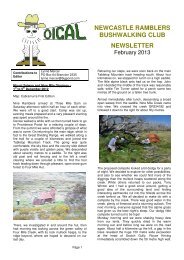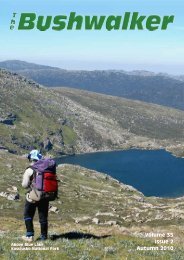Cold Weather Clothing - University of Manitoba
Cold Weather Clothing - University of Manitoba
Cold Weather Clothing - University of Manitoba
- No tags were found...
Create successful ePaper yourself
Turn your PDF publications into a flip-book with our unique Google optimized e-Paper software.
horizontal as possible. This willincrease the amount that can be putinto the pocket and minimize thepossibility <strong>of</strong> contents falling outrespectively.Zippers must be able to beOPERATED WITH MITTS ON. Thiscan be greatly assisted byattachment <strong>of</strong> 5-8 cm (2-3”) tabs toEACH zipper on a garment. Again,fashion concerns dictate that zippersbe small and inconspicuous.Unfortunately, all things beingequal, small zippers ‘catch’ or ‘snag’more <strong>of</strong>ten and are more prone tobreaking. They are alsoconsiderably more difficult tooperate, even with the tabs.c) Length and overall coverage.One major weakness in a clothingensemble is <strong>of</strong>ten the decreasedthermal insulation at the waist. It isimportant that upper and lowerbody garments either arecontinuous (one piece or attached)or overlapping. It is important t<strong>of</strong>orgo the fashionable short jacketfor a longer model that will overlapyour pants and protect your seatwhile you are sitting. Extraprotection can also be gained byswitching from a normal pant to abib design for the outer layer.d) Ventilation. It is EXTREMELYimportant to be able to ventilate aclothing ensemble while it is beingused. Two main functions <strong>of</strong>clothing ventilation are: 1) removal<strong>of</strong> water vapor from inside theensemble; and 2) to allowconvective, conductive, evaporativeand even radiative heat loss fromthe skin surface. Ventilation may befacilitated by opening sleeve ends,‘pit zips’ and the front zipper (whichis a reason not to use a solid frontpullover design). The ‘pit zips’should be long enough to actuallyallow the arms to be placed throughthem, if the need to increaseradiative and convective heat lossfrom the arms occurs.STRATEGIES FOR USING CLOTHING1) Layering design. The clothingensemble should have several layersinstead <strong>of</strong> one large thick layer. Thisprovides the obvious advantage <strong>of</strong>fine-tuning or adjusting the thermalinsulation value in order to adjust towarmer or colder conditions. Inaddition, each layer should also bechosen to perform specific tasks.a) Inner layer. It is commonknowledge that the inner layer(usually polyester) should be highlyvapor permeable so that moisture istransferred or ‘wicked’ away fromthe skin through to the next layers<strong>of</strong> clothing. Having dry skin greatlyincreases one’s comfort level.b) Middle layer(s). The middlelayer(s) are mainly for insulationand can be fleece, pile, wool or eventhicker polyester. It should bereemphasized that this middle zoneshould comprise multiple insulativelayers rather than one thicker layer.c) Outer layer. The main function<strong>of</strong> this layer is to provide windand/or moisture protection,depending on the prevailingconditions. Various materials canbe used including Gortex, 60/40cloth, cordura, windstopper (PTFElaminate), nylon, and others.2) Layering Strategy. As stated above, itis important that a clothing ensemble<strong>Cold</strong> <strong>Weather</strong> <strong>Clothing</strong> 4 Gordon Giesbrecht
It is also important to care for clothingaccording to manufacturer’sinstructions. For instance, Gortexgarments should be washed(remember to follow instructions)periodically in order to remove dirtparticles from the pores in the material.Otherwise the moisture transfercharacteristics may be greatlycompromised.A PRIMER ON MOISTURE CONDENSATION WITHIN CLOTHINGAs stated above, it is VITALLYIMORPORTANT that water vapor passthrough the clothing layers beforecondensing into liquid form. Ifcondensation does occur, liquid moisturemust reach, AND PASS THROUGH theoutside layer <strong>of</strong> the clothing before itfreezes. In a cold environment, themoisture may freeze and be trappedwithin the clothing.It is time for a little science here. The DewPoint is the important factor determiningif, and where, moisture vapor condenses.As air temperature decreases, it can holdless water in vapor form. Consider atemperature at which air is completely(100%) saturated with moisture vapor. Ifair temperature then decreases, theresultant maximum vapor capacity <strong>of</strong> theair will be lower than what was in vaporform just before the temperaturedecreased. Thus, some <strong>of</strong> the moisture willcondense or form liquid water. Thisthreshold temperature is the Dew Point.BodyInsulationBodyInsulationWarmEvaporationWarmGortexTDew PointTDew PointFigure 2 indicates that temperature (T) decreases as water vapor (light circles) moves from thewarm body, through the clothing to the exterior environment. When the air temperaturedecreases below the Dew Point (dashed line), condensation will occur. Left Panel. If the liquidmoisture (dark circles) can still pass through the material it will evaporate with minimalmoisture accumulation within the material itself (Left).The Right Panel illustrates a potential problem with a “liquid-resistant, vapor-permeable”material, such as Gortex, in extreme cold. If the Dew Point is reached within the clothing, theliquid moisture cannot escape through the liquid-resistant membrane. It then freezes (clearcircles) within the clothing, thus addidng weight and decreasing insluation.<strong>Cold</strong> <strong>Weather</strong> <strong>Clothing</strong> 6 Gordon Giesbrecht
BodyInsulationBodyInsulationBodyInsulationGortexWarmHotEvapHotEvapTDewTDewTDewFigure 3 indicates some strategies to minimize moisture accumulation within clothing.Left Panel – Multiple layering increases the chance that the temperature reaches the DewPoint somewhere between clothing layers. Thus if moisture condenses and freezesbetween the layers, ice can be brushed <strong>of</strong> from the material surfaces instead <strong>of</strong> beingtrapped with the material itself.Center Panel – Heavy work will increase the skin surface temperature. The newtemperature pr<strong>of</strong>ile (dark line) shows that the Dew Point occurs past the outside layer<strong>of</strong> the clothing instead <strong>of</strong> within the material, as would have occurred with a lowerinitial skin temperature (light line).Right Panel – This shows that an increased skin temperature is required to allow the forcing<strong>of</strong> moisture vapor through the “liquid-resistant, vapor-permeable” surface materialbefore it condenses and evaoprates or freezes.Based on these principles, it is advisable that the outer shell should not be combined withthe insulation. Therefore if condensation and freezing does occur on the inside <strong>of</strong> theouter layer it can be brushed <strong>of</strong>f.CONCLUSIONRemember the following points and you will go a long way to ensuring comfortablesafe clothing use in the harsh cold climate:1) THERE IS NO SUCH THING AS BAD WEATHER… ONLY BAD CLOTHING.2) As much as possible, the clothing ensemble should be designed for thespecific conditions to be encountered.3) You can widen the window <strong>of</strong> conditions in which a specific clothingensemble can be used, even though they are outside the parameters that theensemble was originally designed for.4) KEEP WATER MOLECULES OUT OF THE CLOTHING ENSEMBLE !!!!!This requires commitment to:a) Proactive layering changes,b) Aggressive clothing ventilation to expel moisture during the day,c) Continued efforts to remove moisture at the end <strong>of</strong> the day.<strong>Cold</strong> <strong>Weather</strong> <strong>Clothing</strong> 7 Gordon Giesbrecht
















